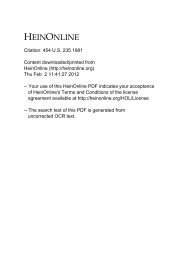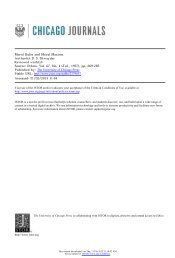The Educational Boundary. - The University of Texas at Austin
The Educational Boundary. - The University of Texas at Austin
The Educational Boundary. - The University of Texas at Austin
Create successful ePaper yourself
Turn your PDF publications into a flip-book with our unique Google optimized e-Paper software.
<strong>The</strong> consultant advised against the analysand serving in th<strong>at</strong> way, noting th<strong>at</strong>, ‘From inside the dyad, allkinds <strong>of</strong> self-deception are possible because <strong>of</strong> thetransference-countertransference wishes.’<strong>The</strong> following day, with further reflection, both members <strong>of</strong> the analytic dyad decided th<strong>at</strong> theanalysand should assume an important role in institute life th<strong>at</strong> would not involve constant administr<strong>at</strong>ivecontact with her analyst. This example contrasts with wh<strong>at</strong> happened in the example entitled ‘An effort tosupport the administr<strong>at</strong>ion <strong>of</strong> the institute.’ Here, in contrast, there was a purposeful penetr<strong>at</strong>ion <strong>of</strong> theeduc<strong>at</strong>ional boundary, through the use <strong>of</strong> a requested consult<strong>at</strong>ion. <strong>The</strong> result was th<strong>at</strong> the misuse <strong>of</strong> ananalysand was avoided.ConclusionIn this paper, we have tried to provide examples <strong>of</strong> situ<strong>at</strong>ions requiring our awareness, as analyticeduc<strong>at</strong>ors, <strong>of</strong> our own personal shortcomings, our ways <strong>of</strong> experiencing group pressures, and our need tobe sensitive to protecting, maintaining, or penetr<strong>at</strong>ing the educ<strong>at</strong>ional boundary. We believe th<strong>at</strong> if we areaware <strong>of</strong> and discuss these issues regularly, when functioning as educ<strong>at</strong>ors, we would more readilyrecognize wh<strong>at</strong> motiv<strong>at</strong>es us as we consider staying out <strong>of</strong> or penetr<strong>at</strong>ing the boundary <strong>of</strong> acandid<strong>at</strong>e's analysis, or supervisory rel<strong>at</strong>ionship, or student-teacher rel<strong>at</strong>ionship.In our examples <strong>of</strong> problem situ<strong>at</strong>ions, the consequences <strong>of</strong> the actions and inactions <strong>of</strong> faculties wereneither examined system<strong>at</strong>ically nor remedied institutionally <strong>at</strong> the time the problems occurred, andpersonal, educ<strong>at</strong>ional, and administr<strong>at</strong>ive challenges were not seen for wh<strong>at</strong> they were. Even though thesitu<strong>at</strong>ions as we write <strong>of</strong> them are dram<strong>at</strong>ically clear, and on some level in each instance <strong>at</strong> least somefaculty members knew th<strong>at</strong> their institutes were suffering from the misbehavior or acting out <strong>of</strong> eventroubled analysts, nothing was done <strong>at</strong> the time to address wh<strong>at</strong> was wrong.- 214 -We want to underscore our view th<strong>at</strong> most faculty analysts who act in the ways we have described doso without full awareness <strong>of</strong> the consequences <strong>of</strong> their personal shortcomings or interpersonal motiv<strong>at</strong>ionsand behavior. This is so because we are members <strong>of</strong> a pr<strong>of</strong>ession where regression and keeping secrets arewh<strong>at</strong> we are accustomed to living with, which renders our complex task <strong>of</strong> self-reflection andinterpersonal cooper<strong>at</strong>ion even more difficult. But we also want to emphasize th<strong>at</strong> our pr<strong>of</strong>ession's failureto carefully deline<strong>at</strong>e the ethical principles and standards th<strong>at</strong> should govern the educ<strong>at</strong>ion <strong>of</strong> candid<strong>at</strong>es,and study the use and misuse <strong>of</strong> educ<strong>at</strong>ional boundaries during th<strong>at</strong> educ<strong>at</strong>ional process, must beremedied. Most analysts who have failed in the ways we have described have done so because they areunaware <strong>of</strong> the psychodynamics motiv<strong>at</strong>ing their and their colleagues' thoughts and actions in theeduc<strong>at</strong>ional arena, the group process pressures influencing them, and the concept <strong>of</strong> the educ<strong>at</strong>ionalboundary. Attention to educ<strong>at</strong>ional ethics and boundaries is a critical step we must take, as we work toenhance our awareness <strong>of</strong> our motiv<strong>at</strong>ions, and the influences on us th<strong>at</strong> come from our particip<strong>at</strong>ion ineduc<strong>at</strong>ional groups. We hope th<strong>at</strong> this paper will increase the focus on the need for both personal andorganiz<strong>at</strong>ional remedies for these difficulties and thus help analytic educ<strong>at</strong>ors function more effectivelyand humanely.Transl<strong>at</strong>ions <strong>of</strong> SummaryDie Ausbildungsgrenze. In diesem Beitrag definieren und diskutieren die Autoren dieAusbildungsgrenze in der analytischen Ausbildung, die sie für ein häufig ignoriertes und nützlichesKonzept in der psychoanalytischen Ausbildung halten. Der Rahmen, auf den sich ihre Diskussion stützt,umfasst die Aufmerksamkeit, die Psychoanalytiker in der jüngsten Vergangenheit Fragen der Grenzen undder Ethik gewidmet haben. Ein weiterer Eckstein dieser Diskussion ist ihr Verständnis, wie die klinischeArbeit das Denken des Analytikers, der gleichzeitig Lehrer ist, beeinflusst, sowie die Art und Weise, wiedie Persönlichkeit des jeweiligen Analytikers seinen Umfang mit anderen Dozenten und Kandid<strong>at</strong>enbeeinflusst. Die Autoren vertreten die Ansicht, dass viele der in der Ausbildung von Analytikernauftauchenden institutionellen Probleme besser verstanden werden können, wenn man sie durch dasPrisma der Ausbildungsgrenze untersucht. Anhand mehrerer Beispiele illustrieren sie, wiepsychoanalytische Lehrer die Ausbildungserfahrung der Kandid<strong>at</strong>en erschweren, formulieren spezifischeErklärungen für die Schwierigkeit, mit der Analytiker ringen, wenn sie ihre ausbildungsbezogenenInterventionen einzubringen versuchen, und zeigen in einer Diskussion potentieller Heilmittel auf, dasssolche Verhaltensweisen vermieden werden könnten, wenn die Ausbildungsgrenze einen Fokus bildete.Sie schildern auch ein Beispiel für einen effizienteren Umgang mit der Ausbildungsgrenze.Los límites en la formación psicoanalítica. En esta contribución los autores definen y discuten los
















